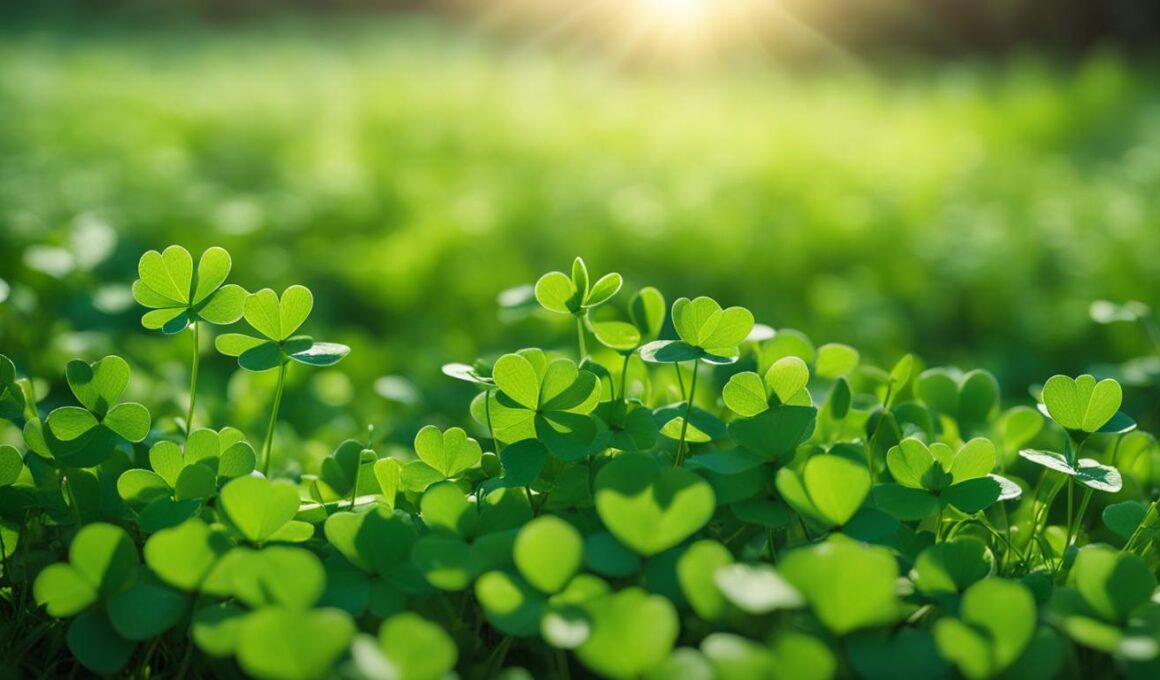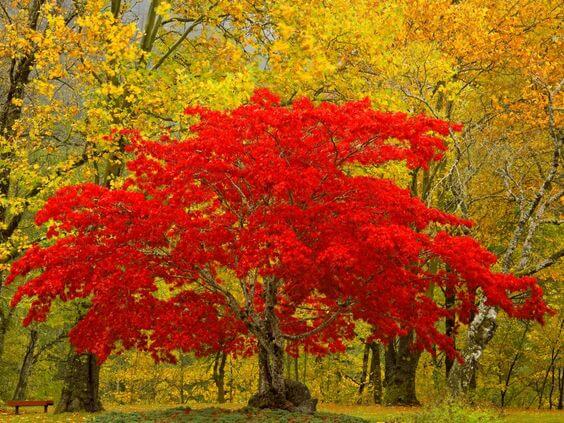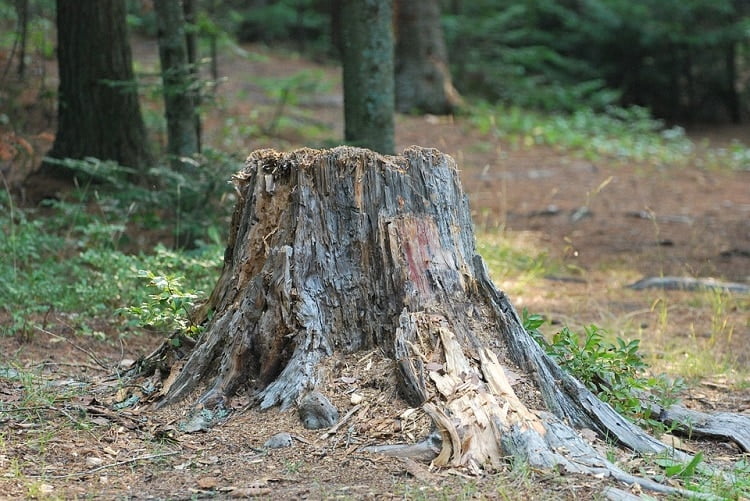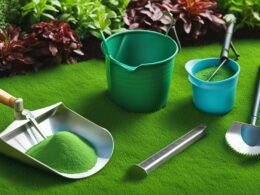Considering transforming your lawn into a micro clover lawn? Before making a decision, it’s essential to weigh the pros and cons. Microclover is a low-growing, dwarf variety of the common white Dutch clover that offers unique benefits and drawbacks. Understanding these factors will help you make an informed choice for your lawn. This quick guide explores the advantages and disadvantages of micro clover lawns, allowing you to assess whether it’s the right option for you.
- Microclover is a low-maintenance alternative to a traditional grass lawn.
- It reduces water usage and conserves resources.
- Microclover helps to attract pollinators, enhancing biodiversity in your yard.
- However, it has limited tolerance to drought and shade.
- The establishment period may require extra attention and care.
To gain a deeper understanding, let’s delve into the details of microclover, its benefits, and potential drawbacks. This comprehensive guide will equip you with the knowledge needed to determine if a micro clover lawn is the right fit for your needs.
What is Microclover?
Microclover is a variety of small white clover known for its low-growing nature and small leaves. It is a low-maintenance ground cover option that can be mixed with different types of grass lawns. Microclover is particularly popular in Europe and is steadily gaining popularity in the United States.
The most popular microclover varieties in the U.S. are “Pirouette” and “Pipolina.” These varieties typically grow 4-6 inches tall and have better tolerance for close mowing compared to other clover varieties.
Microclover is a low-growing variety of white Dutch clover, perfect for those who desire a lush and eco-friendly lawn.
Benefits of Microclover
Microclover offers numerous benefits for lawns, making it an excellent choice as an eco-friendly groundcover. By incorporating microclover into your lawn, you can enjoy the following benefits:
- Reducing erosion: Microclover forms a dense mat of foliage that helps prevent soil erosion, making it ideal for sloped areas.
- Crowding out weeds: The vigorous growth of microclover helps smother common weeds, reducing the need for chemical herbicides.
- Fixing atmospheric nitrogen: Microclover has the ability to convert atmospheric nitrogen into a usable form for other plants, naturally fertilizing your lawn.
- Creating nutrient-rich green manure: As microclover decomposes, it releases valuable nutrients into the soil, improving soil health and fertility.
- Reducing lawn maintenance: Microclover requires less mowing than traditional grass lawns, saving you time and effort.
- Conserving water: Microclover has deep roots that help retain moisture in the soil, reducing the need for frequent watering.
- Saving money and time: With its low maintenance requirements and reduced need for fertilizers and herbicides, microclover can save you money on lawn care.
- Attracting pollinators: Microclover produces small white flowers that attract bees and other beneficial pollinators, promoting biodiversity in your yard.
- Discouraging grass fungus and diseases: The dense growth of microclover can help prevent the development of fungal diseases that commonly affect grass lawns.
- Resisting lawn pests: Microclover’s strong root system and dense growth make it more resistant to common lawn pests.
- Hardy in cold weather: Microclover is tolerant of cold temperatures, ensuring year-round greenery in your lawn.
- Growing in compacted soil: Microclover can thrive in compacted soil conditions, improving the health of heavily trafficked areas.
- Providing food source for wildlife: Microclover attracts wildlife such as rabbits, providing a food source and promoting biodiversity in your yard.

Special Benefits of Microclover
Microclover has two unique advantages compared to regular white clover. Firstly, it grows well with turfgrasses without crowding them out, making it an excellent option for mixed lawns. It grows less aggressively, forms fewer clumps, and can be planted with various grass and groundcover varieties.
Secondly, microclover has a tidier appearance than regular clover, with smaller leaves and better tolerance for close mowing. It can produce smaller leaves and prevent the appearance of flowers with regular mowing, achieving a more traditional green lawn look.
Microclover’s ability to coexist with turfgrasses offers special benefits for those looking to maintain a lush and uniform lawn appearance. With its less aggressive growth and compatibility with various grass and groundcover varieties, microclover can enhance the overall aesthetic of your lawn.
The image above visually demonstrates the improved appearance that microclover can bring to your mixed lawn.
Pros and Cons of Microclover Lawns
Making the decision to have a microclover lawn brings both advantages and disadvantages. Understanding the pros and cons will help you determine if it’s the right choice for you.
Pros of Microclover Lawns
- Improved Soil Health: Microclover improves soil health by fixing atmospheric nitrogen, which fertilizes other plants and reduces the need for chemical fertilizers.
- Reduced Water Usage: Microclover requires less water than traditional grass lawns, contributing to water conservation efforts.
- Lush Green Appearance: Microclover lawns maintain a lush green appearance throughout the year, adding beauty to your outdoor space.
- Low Maintenance: Microclover lawns have reduced maintenance requirements, saving you time and effort compared to traditional grass lawns.
- Tolerance of Heat and Sun Exposure: Microclover lawns have good tolerance for heat and sun exposure, making them suitable for sunny areas.
- Pollinator Attraction and Enhanced Biodiversity: Microclover lawns attract pollinators, such as bees, and contribute to enhancing biodiversity in your yard.
- Weed Suppression: Microclover’s dense growth helps suppress common weeds, reducing the need for herbicides.
- Nitrogen Fixation: Microclover fixes atmospheric nitrogen, enriching the soil and reducing the need for nitrogen fertilizers.
- Increased Soil Moisture Retention: Microclover lawns help retain moisture in the soil, reducing water runoff and promoting healthy plant growth.
Cons of Microclover Lawns
- Limited Tolerance to Drought and Shade: Microclover lawns have reduced tolerance to drought and shade compared to some grass varieties.
- Potential for Insect Stings: Microclover lawns may attract stinging insects like bees and wasps, which can pose a risk, especially for individuals with allergies.
- Limited Tolerance to Heavy Foot Traffic: Microclover lawns are not as tolerant to heavy foot traffic as some grass varieties, potentially resulting in more wear and tear.
- Aesthetics Not Like a Grass Lawn: Microclover lawns have a different appearance compared to traditional grass lawns, which may not be preferred by some individuals.
- Initial Establishment Period: It takes time for microclover lawns to establish fully and reach their optimal appearance.
- Potential Attraction of Stinging Insects: Microclover lawns may attract stinging insects due to the presence of flowering clover blossoms.
Considering the pros and cons of microclover lawns will help you make an informed decision based on your specific needs and priorities.
Conclusion
Before making a decision about establishing a clover lawn, it’s crucial to weigh the pros and cons based on your individual preferences and specific circumstances. While clover lawns, particularly microclover, offer numerous benefits such as improved soil health, reduced maintenance, and enhanced biodiversity, there are also some drawbacks to consider.
One of the main cons of clover lawns is their limited tolerance to drought and heavy foot traffic. If you live in an area with frequent water restrictions or have an active household with children or pets, these factors may impact your decision. However, if you prioritize a lawn that requires less maintenance, conserves water, and attracts pollinators, clover lawns may still be a viable choice.
The decision ultimately comes down to evaluating your priorities and needs. If you value a traditional grass lawn aesthetic, tolerate higher maintenance requirements, and prioritize foot traffic tolerance, then a clover lawn may not be the best fit. However, if you prioritize eco-friendly practices, reducing chemicals in your lawn, and creating an environment that benefits pollinators and biodiversity, then a clover lawn, such as microclover, could be a great option for you.
What are the pros and cons of different clover varieties compared to micro clover for lawns?
There are various varieties of clover types that can be used for lawns, each with its own set of pros and cons. While some offer better drought resistance and nitrogen fixation, others may be more invasive and difficult to manage. Micro clover, on the other hand, is a smaller option that can create a lusher, thicker lawn but may require more maintenance.
FAQ
What is microclover?
Microclover is a low-growing, dwarf variety of the common white Dutch clover that can be used as a supplement for turfgrass or an alternative to a traditional grass lawn.
What are the benefits of microclover?
Microclover offers several benefits, including reducing erosion, crowding out common weeds, fixing atmospheric nitrogen to fertilize other plants, reducing lawn maintenance, conserving water, and attracting pollinators.
Are there any drawbacks to using microclover?
Yes, there are some drawbacks to consider when using microclover, such as its limited tolerance to drought and shade, more expensive seed cost, lower tolerance to foot traffic, susceptibility to southern blight disease, and the attraction of stinging insects.
Can microclover be mixed with different types of grass lawns?
Yes, microclover can be mixed with different types of grass lawns to create a low-maintenance ground cover option.
What are the special benefits of microclover?
Microclover has two unique advantages compared to regular white clover. Firstly, it grows well with turfgrasses without crowding them out, making it an excellent option for mixed lawns. Secondly, it has a tidier appearance with smaller leaves and better tolerance for close mowing, achieving a more traditional green lawn look.
What are the pros and cons of microclover lawns?
Pros of microclover lawns include improved soil health, reduced water and chemical usage, lush green appearance, low maintenance requirements, tolerance of heat and sun exposure, pollinator attraction, enhanced biodiversity, weed suppression, nitrogen fixation, and increased soil moisture retention. Cons include limited tolerance to drought and shade, potential for insect stings, limited tolerance to heavy foot traffic, aesthetic differences from a grass lawn, longer establishment period, and potential attraction of stinging insects.
Should I choose a microclover lawn?
Before deciding to establish a microclover lawn, it’s important to consider the pros and cons based on individual preferences and specific circumstances. While microclover offers several benefits, such as improved soil health and reduced maintenance, there are also some downsides, including limited tolerance to drought and heavy foot traffic. Ultimately, the decision should be based on an evaluation of the individual’s priorities and needs.










